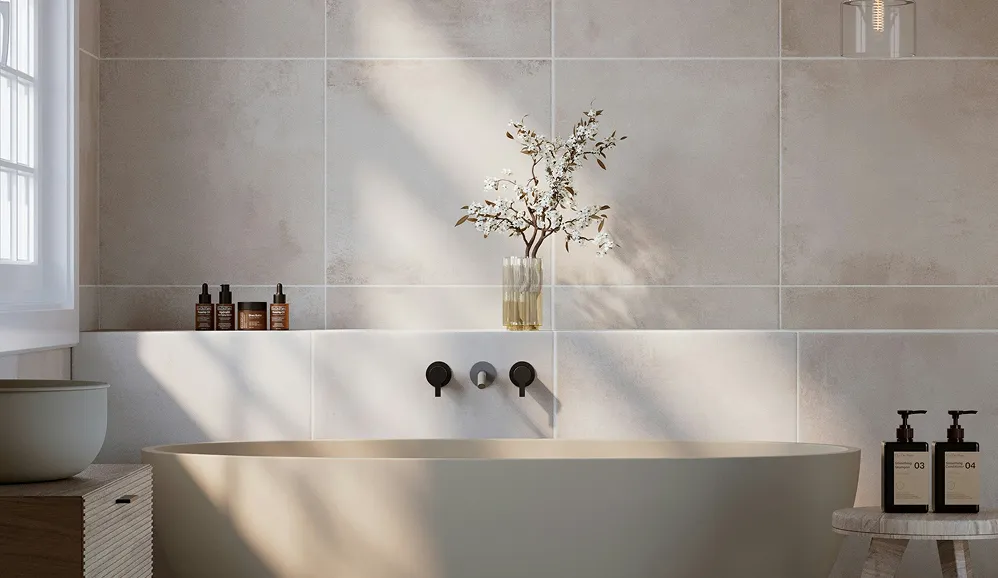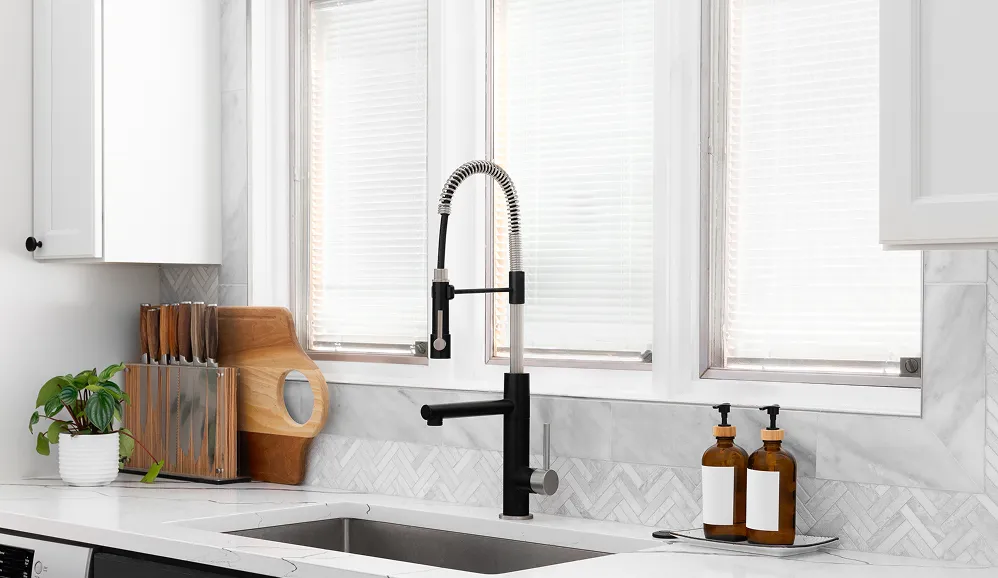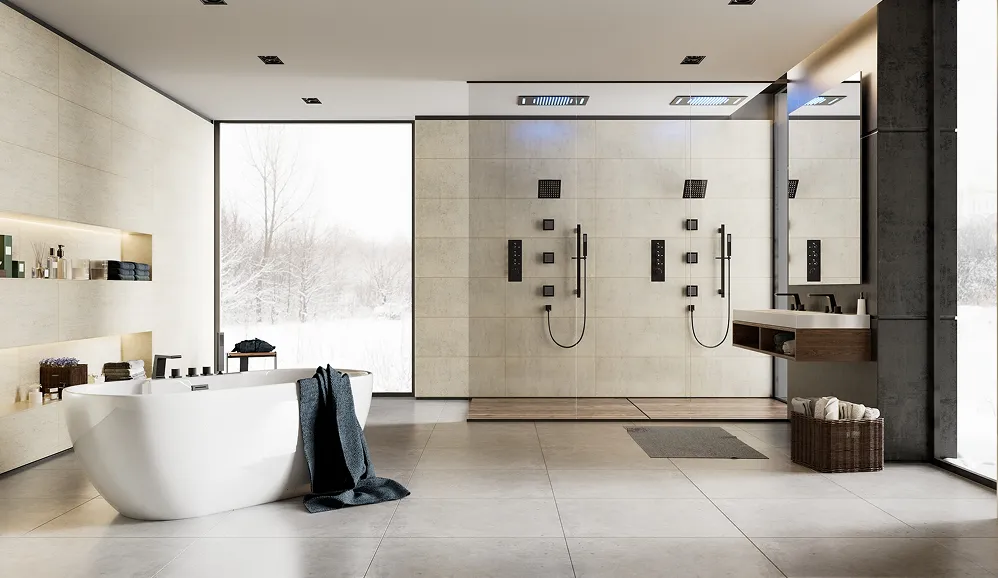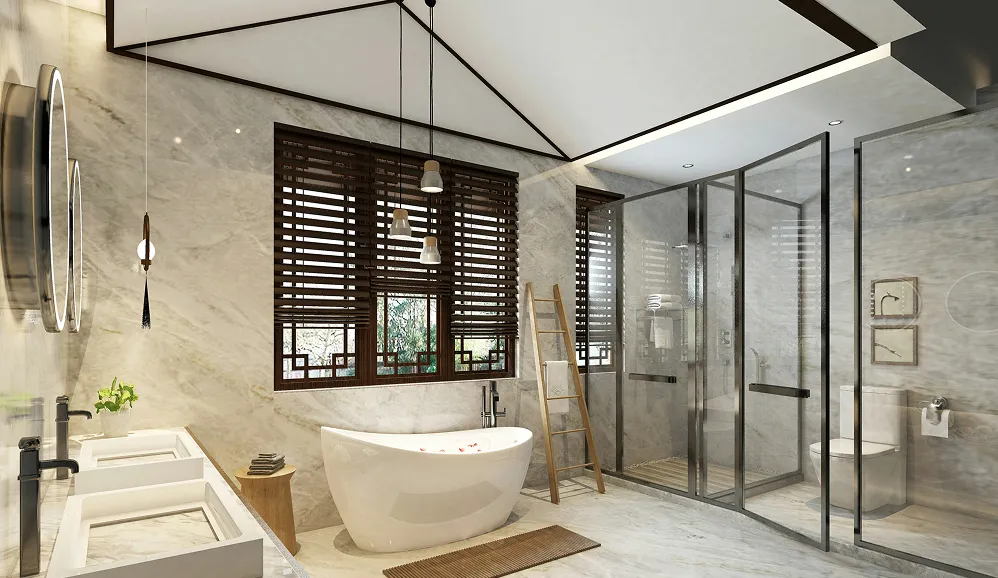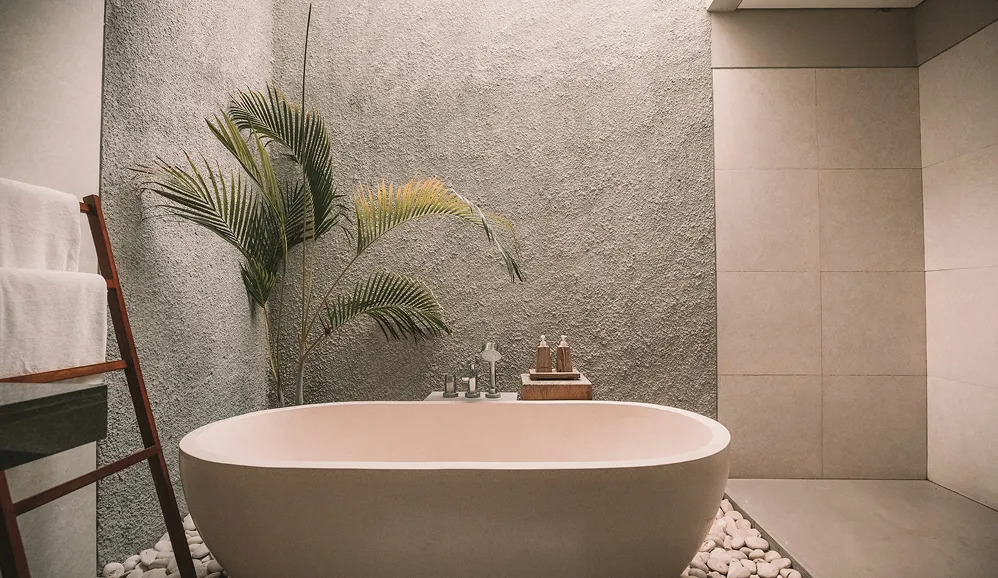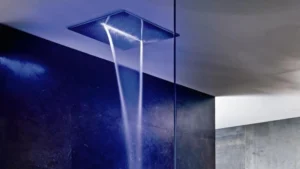Ever stop to wonder how your shower hits that perfect temperature with just a tiny turn of the handle? The magic happens inside the wall, thanks to the shower valve—the unsung hero of your entire plumbing system.
In a nutshell, a shower valve is the sophisticated traffic controller for your home’s water supply. Its job is to expertly blend the hot and cold water lines before a single drop even reaches your showerhead.
Your Shower’s Unseen Command Center
Think of the shower valve as the brains behind your whole shower experience. It’s tucked away out of sight, but this little device does a whole lot more than just turn the water on and off. Its real mission is to precisely mix hot and cold water to deliver a stream that’s not just comfortable, but more importantly, safe.
Without a good valve, you’re vulnerable to “thermal shock.” That’s the sudden, jarring blast of scalding hot or ice-cold water that happens when pressure changes elsewhere in the house—like when someone flushes a toilet or the washing machine kicks on. The valve is your guardian, instantly adjusting to those pressure shifts to keep your shower temperature steady and predictable.
Core Functions of a Shower Valve
Let’s break down the essential jobs this device handles every single day. Getting to know components like these gives you a much better appreciation for the entire plumbing and HVAC industry and the smart engineering that goes into modern home comfort. For an authoritative overview, resources like the Plumbing-Heating-Cooling Contractors Association (PHCC) offer deep insights into industry standards.
A quick look at the primary jobs your shower valve performs every day.
| Function | Description | Primary Benefit |
|---|---|---|
| Temperature Mixing | Blends hot and cold water supplies to achieve the desired output temperature. | Provides a comfortable and customized shower experience. |
| Flow Control | Regulates the volume of water sent to the showerhead or tub spout. | Allows you to manage water usage and pressure. |
| Anti-Scald Protection | Automatically adjusts water mix to prevent sudden, dangerous temperature spikes. | Enhances safety, especially for children and the elderly. |
At the end of the day, the valve is what ensures your shower is a reliable and therapeutic retreat, not a risky gamble. Its performance is directly tied to everything from water pressure to temperature consistency. If you want to dive deeper into how flow rates play a role, check out our guide on understanding shower GPM. It’s the kind of knowledge that helps you appreciate the incredible engineering behind every single relaxing shower you take.
A Look Inside Your Shower Valve
To really get what’s going on with your shower, you have to look past the handle on the wall. Tucked away behind your tile is a clever piece of engineering designed to keep you safe and comfortable. Think of it as the central nervous system for your shower, managing every drop of water before it ever reaches you.
This whole assembly has a few core parts that work together like a well-oiled machine. Each one has a very specific job to do.
- The Valve Body: This is the heavy-duty brass housing that’s plumbed directly into your home’s hot and cold water lines. It’s the rugged foundation holding everything together, built to stay buried in the wall for decades.
- The Cartridge: You could call this the “brain” of the operation. It’s the piece you control with the handle. When you turn it, the cartridge slides or rotates, opening and closing little ports inside to mix the hot and cold water just right, giving you the temperature and flow you want.
- The Pressure-Balancing Spool: Meet your shower’s silent bodyguard. This little piston is all about safety, reacting in a split second to any sudden pressure changes. If someone flushes a toilet and the cold water pressure drops, the spool instantly moves to cut back the hot water flow, stopping you from getting a nasty, scalding surprise.
The Heart of the Matter: The Cartridge
You could argue the cartridge is the most important—and busiest—part of the whole shower valve. It’s the component that turns your simple twist of the handle into a perfectly warm stream of water.
Because it has moving parts and rubber seals, it’s also the piece most likely to wear out over time. When it does, you’ll start noticing drips, a stiff handle, or trouble getting the temperature right.
Understanding the cartridge is the first step to fixing most common shower problems. When a valve starts acting up, this little part is almost always the reason why. The good news is, you can usually replace it and get your shower working like new without having to tear open the wall.
Learning how this component works is a great skill for any homeowner. For a step-by-step guide, you can learn more about how to remove a shower valve cartridge from our team. Knowing your way around these mechanics will empower you to keep your shower running perfectly for years.
The Journey to the Modern Shower Valve
The simple act of getting the perfect shower temperature wasn’t always so easy. What we take for granted today is actually the result of decades of clever engineering, with each new idea solving a real-world problem to make our daily routines safer and more comfortable. It’s a fascinating story of innovation, tracing the path from old-fashioned two-tap systems to the smart valves in modern homes.
Think back to old plumbing. You had to manually juggle separate hot and cold taps, a constant and often frustrating guessing game to avoid getting blasted with ice-cold or scalding water. A huge breakthrough came in 1937 when an inventor, after getting burned himself by a sudden burst of hot water, created the single-handle mixing faucet. This design, which blended the water inside the valve, was a massive leap forward.
This new focus on safety and user comfort pushed the industry forward. The next big problem to solve was thermal shock—that shocking temperature spike you get when someone flushes a toilet elsewhere in the house. This common headache led directly to the development of pressure-balancing technology.
The Rise of Safety and Precision
This invention was a landmark moment in plumbing history, dramatically cutting down the risk of scalding injuries in the home. It introduced a smart mechanism that could automatically sense and adjust to sudden pressure drops, keeping the temperature perfectly stable. This innovation paved the way for the precision we now expect from any premium shower system.
The core idea behind a modern shower valve is proactive safety. Instead of forcing you to react to sudden temperature changes, the valve does the work for you, creating a genuinely therapeutic and worry-free experience.
Knowing this history helps you appreciate the different technologies out there today. Each type of valve is a stepping stone on this journey toward perfect control. To see how these designs are used in today’s fixtures, you might want to check out our guide on different shower faucet types.
This backstory shows exactly why a high-quality bathroom shower set isn’t just a luxury—it’s the end result of a long history of making showers safer and more enjoyable for everyone.
Pressure Balanced vs. Thermostatic Valves
When it comes to shower valves, it’s not a one-size-fits-all situation. The two main players on the field are pressure-balanced and thermostatic valves, and they have completely different game plans for keeping your shower safe and comfortable. Getting to know how each one works is the key to picking the right hero for your bathroom.
Think of a pressure-balanced valve as a quick-reacting bodyguard. Its entire job is to sense sudden changes in water pressure. Let’s say someone flushes a toilet elsewhere in the house—the cold water line pressure instantly dips. The valve immediately detects this imbalance and reduces the hot water flow to match, preventing that shocking blast of scalding water. It’s a simple, mechanical, and incredibly effective way to keep you safe.
A thermostatic valve, on the other hand, is more like a precision-minded chef. It doesn’t care about pressure; it only cares about the final temperature of the water. Inside, a wax element expands and contracts with the slightest temperature change, constantly fine-tuning the mix of hot and cold water. This means it holds the temperature exactly where you set it, even if the incoming water pressure goes haywire.
Pressure Power vs. Temperature Precision
At the end of the day, a shower valve is all about mixing hot and cold water without any nasty surprises. Pressure-balancing valves have been a game-changer for home safety, dramatically cutting down on the risk of accidental scalds—which, according to organizations like the American Burn Association, are a significant cause of household injuries.
Thermostatic valves take that safety to the next level with incredible precision, typically holding your set temperature within ±2°F. This is why you’ll often find them in high-end homes and places where absolute temperature stability is a must.
To help you decide which valve is the right fit for your home, we’ve put together a simple comparison.
Pressure-Balanced vs. Thermostatic Shower Valves
| Feature | Pressure-Balanced Valve | Thermostatic Valve |
|---|---|---|
| Primary Function | Balances hot/cold water pressure | Maintains a preset water temperature |
| Control | Single handle controls both volume and temperature | Separate controls for volume and temperature |
| Safety | Good protection against scalding | Excellent protection against scalding |
| Temperature Stability | Good, but can have slight fluctuations | Exceptional, typically within ±2°F |
| Cost | More budget-friendly | Higher initial investment |
| Ideal For | Standard family bathrooms, renovations | Luxury showers, homes with kids or elderly |
Ultimately, the choice comes down to your priorities and budget. A pressure-balanced system is a reliable and cost-effective choice for safety, while a thermostatic setup delivers a true spa-like experience with uncompromising control.
The main takeaway is simple: a pressure-balanced valve controls the ratio of hot to cold water, while a thermostatic valve controls the actual temperature of the water output.
Understanding this difference is crucial when you’re looking for the perfect valve control set. While a pressure-balanced system offers fantastic protection without breaking the bank, a thermostatic shower system provides a more luxurious and precisely controlled shower every single time.
For a deeper look into the mechanics behind the handle, check out our guide covering the different types of faucet valves. Choosing the right technology is the first step toward building your perfect bathroom shower set.
Achieve Perfect Control with CRANACH
Knowing how a shower valve works is one thing, but actually feeling that perfect, unwavering performance day in and day out? That’s something else entirely. It’s where the theory ends and the real experience begins.
This is exactly where CRANACH engineering comes in. We take those advanced thermostatic principles and turn them into a luxurious shower you can actually feel—one that’s both therapeutic and, above all, safe. Every single time.
At the heart of every CRANACH shower system is our thermostatic control technology. It’s the brains of the operation, ensuring the water temperature stays precisely where you set it. This isn’t just about standard anti-scald protection; it’s about giving your family total peace of mind by eliminating those dangerous, unexpected temperature spikes for good.
Elevate Your Existing or New Bathroom
It doesn’t matter if you’re giving your current setup a much-needed upgrade or designing a brand-new bathroom from scratch. CRANACH has a solution that fits.
- Our premium valve control set is the perfect way to bring superior temperature stability and a touch of modern design to your existing shower.
- For a totally seamless and integrated setup, our complete bathroom shower set pairs our advanced valve with high-performance showerheads and hand showers that all work in harmony.
Choosing a CRANACH shower system is really an investment in your daily comfort and well-being. By combining top-tier, lead-free brass construction with pinpoint-accurate thermostatic control, we deliver a shower that isn’t just luxurious but is reliably and consistently safe.
To see this precision in action, take a look at our Round 2-Outlet Thermostatic Shower Valve. It perfectly captures that balance of beautiful form and flawless function.
Want to explore our collections and find the right fit for your project? Come visit a showroom. Use our store locator to find where to buy CRANACH products near you. For all the industry pros out there, we invite you to join our CRANACH Pro program or ask for a wholesale price to bring this level of quality to your clients.
What’s the Difference Between a Shower Valve and a Diverter?
This is a super common question, and it’s easy to see why people get them mixed up. The two components work together but have totally different jobs. Think of the shower valve as the brain of the operation—it’s the master controller that mixes hot and cold water to set your perfect temperature and manage the flow.
A diverter, on the other hand, is more like a traffic cop. It doesn’t mix anything. Its only job is to direct the flow of that perfectly mixed water. In a tub/shower combo, the diverter is that little knob you pull up or the lever you turn to send water from the tub spout up to the showerhead. It just points the water where you want it to go.
For a truly reliable and therapeutic experience, explore the advanced engineering of CRANACH‘s shower system collections. Upgrade your bathroom with our precision valve control set or a complete bathroom shower set for unmatched safety and comfort. Visit our product pages to find your perfect solution.

